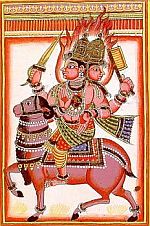Wikipedia
R.H. Allen:
Star Names
Ian Ridpath:
Star Tales
Universe Guide
Sea and Sky:
The Constellations
IAU
Map
NASA:
Constellations
|
Wikipedia |
R.H. Allen: Star Names |
Ian Ridpath: Star Tales |
Universe Guide |
Sea and Sky: The Constellations |
IAU Map |
NASA: Constellations |


|
|
Star LorePleiadesPart 3 - Asia and Pacific |
|


 White Tiger of the West
White Tiger of the West |
Named after the seven daughters of Atlas and Pleione in Greek mythology, the Pleiades are arguably the star formation
with the most recorded star lore. The star cluster is a prominent sight in winter in the Northern Hemisphere. The Pleiades have been observed by humans at least since the Bronze Age. |


Asia |
|
|
India
In Indian astronomy, the Pleiades formed the third
Nakshatra, called Kṛttikā,
meaning "the cutters".
|
 Kṛttikā
KṛttikāSource: astroved.com |


|
|
Tamil
In Tamil mythology, the six brightest stars of the Pleiades are the six wifes of
six of the seven Saptarishi (enlighted pople). The six wives fell in love with
Agni, the Vedic fire god. For that reason, in
Tamil, the Pleiades are called the Star of Fire.
|
 Agni with an aura of flames
Agni with an aura of flamesSource: Wikipedia |


|
|
China
In Chinese astronomy, the asterism we know as the Pleiades is called Mǎo 昴,
meaning "Hairy Head."
|
 Hairy head of the White Tiger statue by Ai Weiwei Source: Wikipedia |


|
|
Japan
 In Japanese, the Pleiades are called 昴 Subaru, meaning "coming together" or "cluster."  As such, they have given their name to the Subaru car manufacturer, whose logo incorporates six stars to represent the five companies that merged into one.  Source: Wikipedia |
 Subaru Logo Source: Wikipedia |


|
|
Thailand
In Thailand, the Pleiades are called Dao Luk Kai, ดาวลูกไก่ meaning "Chick Stars."
|
| The story tells that a poor elderly couple who lived in a forest had raised a family of chickens: a mother hen and her six (or alternately seven) chicks. One day a monk arrived at the couple's home during his Dhutanga journey. Worried that they had no suitable food to offer him, the elderly couple contemplated cooking the mother hen. The hen overheard the conversation, and rushed back to the coop to say farewell to her children. She told them to take care of themselves, and that her death would repay the kindness of the elderly couple, who had taken care of all of them for so long. As the mother hen's feathers were being burned over a fire, the chicks threw themselves into the fire in order to die along with their mother. The deity, impressed by and in remembrance of their love, immortalized the seven chickens as the stars of the Pleiades. In tellings of the story in which there were only six chicks, the mother is included, but often includes only the seven chicks. Source: Wikipedia |
 Thai art chicken
Thai art chickenSource: dreamstime.com |


|
|
Philippines
In the Philippines, the Pleiades are known as "Moroporo", meaning either "the boiling lights" or "flock of birds". Their
Heliacal rising signified the preparation for the new planting season.
|


|
|
Java
On the Indonesian island Java, the Pleiades are called Lintang Kartika or
Gugus Kartika; Kartika meaning cluster, taken from the Sanskrit Kṛttikā.
|

|


|
|
Sulawesi
The Bugis sailors
called the Pleiades worong-porongngé bintoéng pitu, meaning "cluster of seven stars."
|


Pacific |
|
 Lono
LonoSource: shopify.com |
 French Polynesia Matari’i i ni’a Stamp
French Polynesia Matari’i i ni’a Stamptahitiphilatelie.pf |


|
Māori
In New Zealand, the Pleiades are called The Seven Stars of Matariki.
|
 Papa-tūānuku and Rangi-nui
Papa-tūānuku and Rangi-nuiSource: Wikipedia
|

In 2008, New Zealand writer and teacher Toni Rolleston-Cummins wrote a completely new
version of the Matariki story, to engage and entertain her class and make the story of Matariki come alive and have meaning.
 In this story, an adventurous young man called Mitai lives with his seven handsome brothers in the village of Maketu. He watches his brothers become bewitched by seven beautiful women, and under their spell, the brothers no longer eat, look after themselves, work in their gardens or hunt.  Realising the women are Patupaiarehe, fairy women, he knows they must be cast far away. |
 The Seven Stars of Matariki;
everyeducaid.co.nz
The Seven Stars of Matariki;
everyeducaid.co.nz
|
They are given to Urutengangana, the god of the stars, and he
places the patupaiarehe in the heavens farthest from the earth. Yet once a year, at winter solstice, he allows their beauty to shine in the eastern
sky.
 In 2009, Toni Rolleston-Cummins's book, illustrated by Nikki Slade Robinson was placed on the prestigious New Zealand Notable Books List by the Storylines Children's Literature Foundation.  In my opinion, this story is a shining example of the evelution of star lore throughout the centuries.  Source: Huia Bookshop |


 |
Back to Europe and Middle East | Forward to Africa and Australia |
 |


|
Back to Star Lore |
Back to Mythology |

Back to Pleiades |
Back to Space Page |
Back to English |
 Back to Start Page |